Agave vs Stevia Which Natural Sweetener Is Healthier
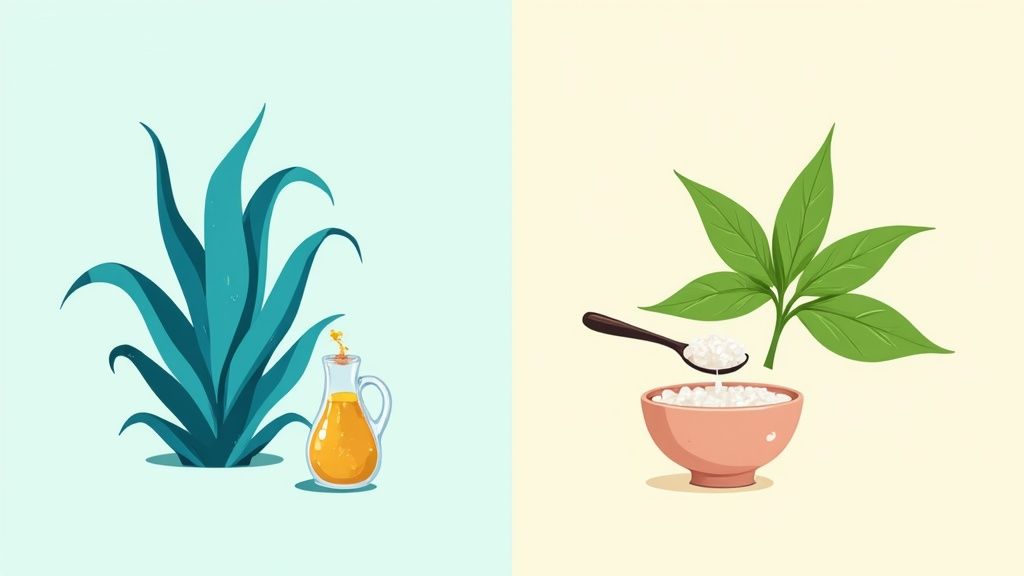
When you're standing in the sweetener aisle, the choice between agave and stevia really boils down to your personal health goals and how you plan to use it. They might both be plant-based sugar alternatives, but they couldn't be more different in how they affect your body.
Stevia is a zero-calorie, zero-sugar powerhouse, making it the clear winner if you're managing diabetes or sticking to a ketogenic diet. Agave nectar, on the other hand, is a syrup with calories and a low glycemic index, but its high fructose content is something to keep in mind, especially regarding liver health.
Agave Vs. Stevia: The Main Differences
Let's get right to it. Both of these sweeteners come from plants, but that's where the similarities end. Agave is a processed syrup from the agave plant, similar in consistency to honey, while stevia is a highly concentrated extract pulled from the leaves of the Stevia rebaudiana plant.
Thinking about which one to grab? This image breaks down the key stats at a glance.
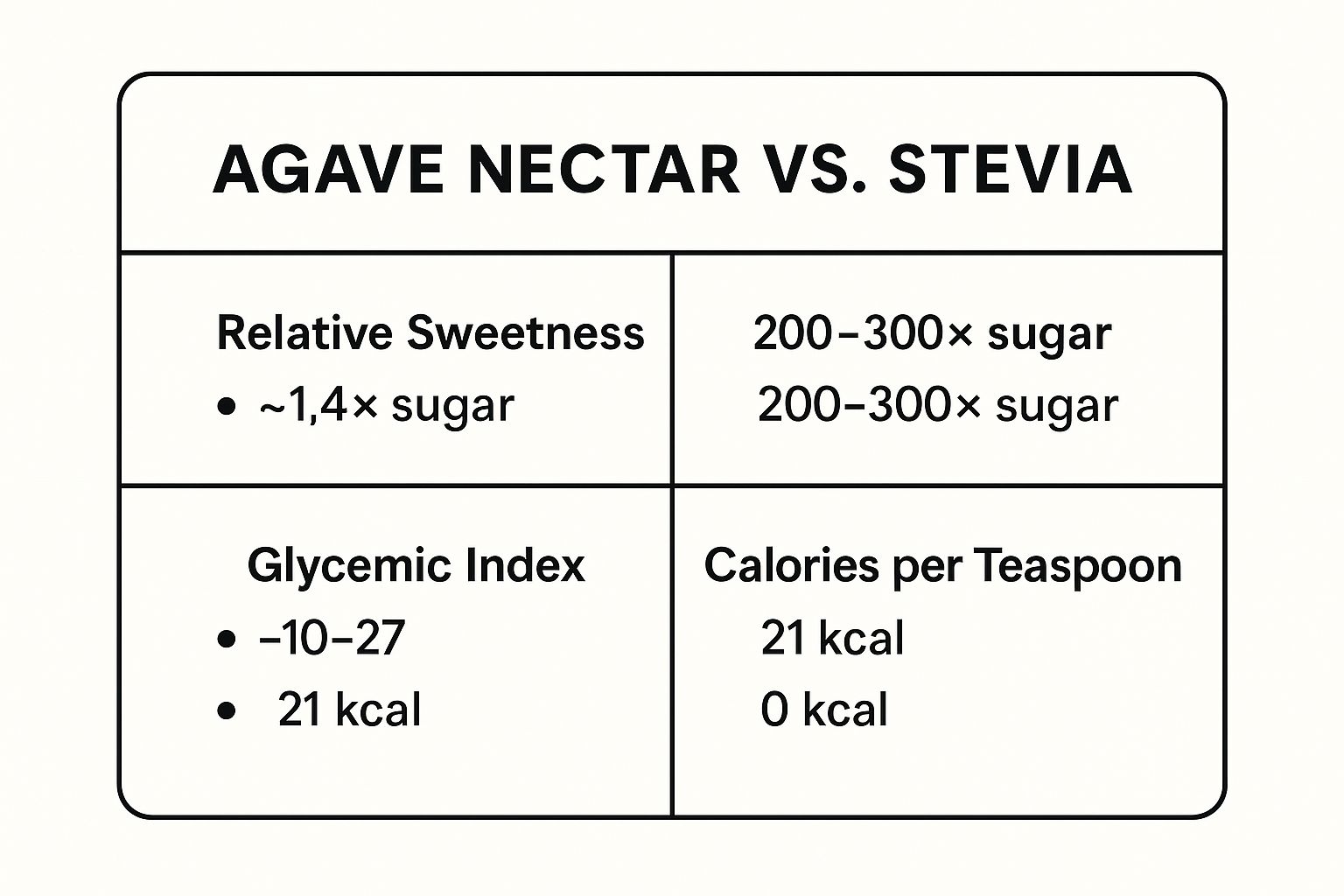
As you can see, stevia delivers pure sweetness without the caloric or blood sugar impact. Agave brings the sweetness too, but it comes with calories and a different metabolic effect.
Quick Comparison: Agave Nectar vs. Stevia Extract
For a simple side-by-side look, this table lays out the core attributes of each sweetener.
| Attribute | Agave Nectar | Stevia Extract |
|---|---|---|
| Source | Sap from the agave plant | Leaves of the Stevia rebaudiana plant |
| Calories (per tsp) | ~21 calories | 0 calories |
| Glycemic Index | Low (10-27) | 0 (no impact) |
| Sweetening Agent | Fructose and glucose | Steviol glycosides |
| Common Form | Liquid syrup | Powder or liquid drops |
| Best For | Vegan honey substitute, sweetening drinks | Calorie-free sweetening, keto/diabetic diets |
This quick comparison makes it easy to see the fundamental distinctions. Agave acts more like a traditional syrup, while stevia is a pure, non-nutritive sweetener.
Where Do Agave and Stevia Come From?
To really get to the bottom of the agave vs. stevia debate, you have to look at where they start. These two sweeteners couldn't be more different, coming from completely separate plants and made through totally distinct processes. This is what shapes everything about them, from taste to how our bodies handle them.
Agave: From Desert Succulent to Syrupy Sweetener
Agave nectar comes from the sap of the Blue Agave plant, a big succulent that grows in Mexico. While the sap has been used traditionally for ages, today's production is a much bigger operation.
First, the sap is collected from the core of the plant. Then it’s filtered and heated, a process that breaks down its complex carbs into simple sugars—mostly fructose. The result is that familiar sweet, thick syrup we see on store shelves.
Agave really took off in recent years as people searched for alternatives to plain old sugar. It became popular because of its low glycemic index, but what makes it unique is its incredibly high fructose content, which can be anywhere from 55% to 90%. You can dig deeper into the global sweetener market trends on Grandview Research.
Stevia: From Humble Leaf to Potent Extract
Stevia’s story starts with a leafy green plant, Stevia rebaudiana, which is actually part of the chrysanthemum family and originally from South America. For hundreds of years, local communities chewed on the leaves or used them to sweeten drinks and traditional medicines.
The interesting thing about stevia is that its sweetness isn't from sugar at all. It comes from powerful little compounds called steviol glycosides that are pulled from the leaves.
Making stevia extract involves steeping the dried leaves in water, much like making tea. This is followed by filtering and purifying the liquid to isolate those super-sweet glycosides. What you’re left with is a zero-calorie powder or liquid that’s intensely sweet but contains no actual sugar. This is the core difference between the two and why they play such different roles in our diets.
A Deep Dive Into Health and Nutrition
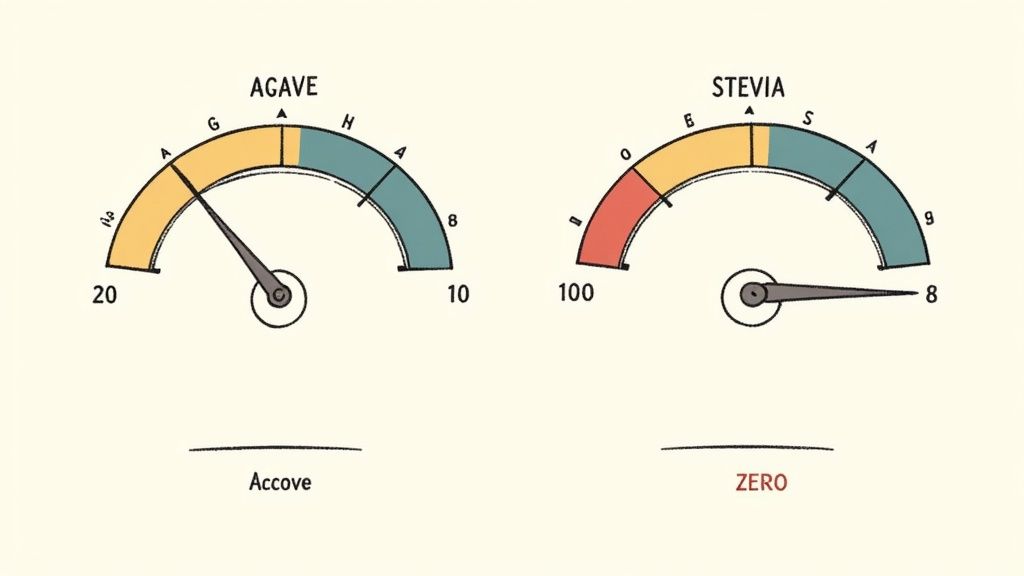
When you put agave and stevia side-by-side, you're looking at two completely different nutritional stories. It’s not enough to know they’re both "natural" sweeteners; what really matters is how your body handles them. Let's get into the specifics to understand what's happening behind the sweet taste.
Stevia is famously a zero-calorie sweetener. That means no sugar, no carbs, and no fat. Because it's a non-nutritive sweetener, it simply passes through your system without being digested, adding nothing to your daily calorie count.
Agave nectar, on the other hand, is a different beast entirely. A single teaspoon has about 21 calories, and nearly all of them come straight from sugar. While you might hear about trace minerals, the amounts are so tiny they don’t offer any real health advantage.
Metabolic Impact and Blood Sugar
Here’s where the two sweeteners really part ways: how they affect your metabolism and blood sugar.
Stevia has a glycemic index (GI) of zero. Plain and simple, it won't raise your blood glucose or insulin levels one bit. This is why it has become a go-to for people with diabetes or anyone on a low-carb diet. If you want a deeper dive into how this works, check out our guide on https://stopsugar.app/blog/what-is-glycemic-index.
Agave’s story is more complicated. It’s often praised for having a low glycemic index, usually somewhere between 10 and 30. The reason for this is its high concentration of fructose, a sugar that doesn't cause an immediate spike in blood glucose like regular table sugar does.
Key Takeaway: A low glycemic index doesn't automatically equal "healthy." The type of sugar and how your body processes it is just as critical as its immediate effect on blood sugar.
The Fructose Factor in Agave
While agave won't give you a sugar rush, its high fructose content is a serious consideration. Agave syrup can be anywhere from 55-90% fructose, which is much higher than even high-fructose corn syrup. This massive fructose load puts a heavy strain on your liver, as it’s the only organ that can process it.
Over time, bombarding your liver with this much fructose can contribute to serious health issues, like non-alcoholic fatty liver disease. When choosing a sweetener, it's important to think about the bigger picture of your diet and the long-term effects, especially when it comes to understanding the risks of ultraprocessed foods. Agave's low GI might look good on paper, but the way it's metabolized is a world away from stevia.
Flavor Profiles and How to Use Them in the Kitchen
Beyond the numbers and nutrition facts, the real difference between agave and stevia shows up when you start cooking. Their taste and texture are miles apart, which means they each have specific jobs where they truly excel.
The Taste of Agave Nectar
Agave nectar has a clean, mild sweetness that reminds most people of a slightly thinner honey. It doesn’t have a funky aftertaste, which makes it a fantastic all-rounder in the kitchen.
Because it’s a syrup, it dissolves instantly in both hot and cold liquids. No stirring forever to get rid of gritty crystals.
This makes it a go-to for things like:
- Sweetening drinks: It’s perfect for iced tea, coffee, lemonades, and cocktails.
- Toppings: Drizzle it over pancakes, oatmeal, or a bowl of Greek yogurt.
- Dressings and glazes: Its liquid form and neutral taste blend right into salad dressings and savory marinades without overpowering other ingredients.
Navigating Stevia’s Unique Flavor
Stevia is a completely different beast. It delivers a massive punch of sweetness—somewhere between 200 to 300 times sweeter than regular sugar. This intensity comes from compounds called steviol glycosides, and they don't taste quite like sugar. Many people notice a slightly bitter or even licorice-like aftertaste, especially with less-refined stevia products.
Pro Tip: The best way to deal with stevia's aftertaste is to pair it with bold flavors. A little lemon juice in your tea, some cocoa powder in a smoothie, or a dash of cinnamon in your coffee can work wonders to balance it out.
This powerful, zero-calorie sweetness makes stevia the star player when cutting sugar is your main objective.
A couple of drops of liquid stevia can sweeten a whole smoothie without adding a single calorie or changing its consistency. For someone on a keto diet, a tiny pinch of powdered stevia is all you need for a cup of coffee. When it comes to the agave vs stevia debate in the kitchen, think of it this way: agave offers versatility, while stevia is a specialist for ultra-low-sugar recipes where you can work with its unique flavor.
How Agave and Stevia Behave in the Kitchen
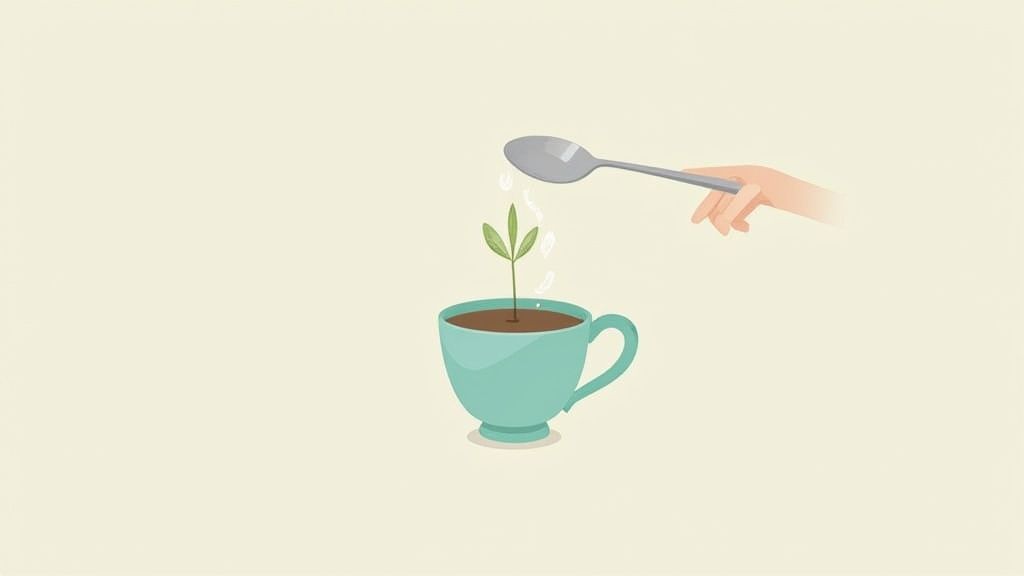
This is where the rubber really meets the road. When you start cooking and baking, the practical differences between agave and stevia become impossible to ignore. They simply don't behave the same way.
Agave nectar, because of its high fructose content, acts a lot like sugar. It adds moisture and helps with browning, which is fantastic if you're making soft cookies or a moist cake.
The downside? That browning happens fast. Baked goods made with agave can go from golden to burnt much quicker than you'd expect. A good rule of thumb is to lower your oven temperature by about 25°F (14°C) and maybe pull back a little on the other liquids in your recipe to keep things from getting scorched.
The Stevia Baking Puzzle
Stevia is a whole different ballgame. It's intensely sweet, but that's all it brings to the party. As a zero-calorie sweetener, it has no bulk, no moisture, and adds zero structure to your recipe. You can't just swap it for sugar or agave and hope for the best.
If you try, you'll likely end up with something dense, dry, and disappointingly flat. The secret to baking with stevia is to add back the volume and moisture it lacks.
Baker's Tip: When using stevia, you need to bring in a "bulking agent" to give your recipe the structure it's missing. Think unsweetened applesauce, pumpkin purée, Greek yogurt, or even extra egg whites. These ingredients add the moisture and body that sugar or agave would normally provide.
When you're trying to bake without sugar, understanding how these alternatives work is everything. Here’s a quick breakdown of what to expect from each.
Sweetener Performance in Baking
| Baking Property | Agave Nectar | Stevia Extract |
|---|---|---|
| Browning (Maillard Reaction) | Excellent browning, but can burn quickly. | Provides no browning at all. |
| Moisture Content | High moisture; keeps baked goods soft and moist. | Adds zero moisture; can lead to dry results. |
| Structure & Bulk | Contributes some bulk, similar to honey or syrup. | Adds no bulk; requires other ingredients for volume. |
| Texture | Helps create a tender, chewy, or soft crumb. | Can result in a dense or crumbly texture if not balanced. |
| Ease of Use | Relatively simple to substitute for other liquid sweeteners. | Requires significant recipe adjustments and bulking agents. |
Ultimately, agave is a pretty straightforward swap for bakers looking for an easy transition from sugar. Stevia, on the other hand, demands more creativity and a willingness to experiment.
If you’re serious about cutting out sugar in your baking, it helps to have a few options in your toolkit. Learning about other healthy sugar alternatives for baking will give you the flexibility to choose the right sweetener for the right job, ensuring your treats come out just the way you want them.
How To Choose The Right Sweetener For You
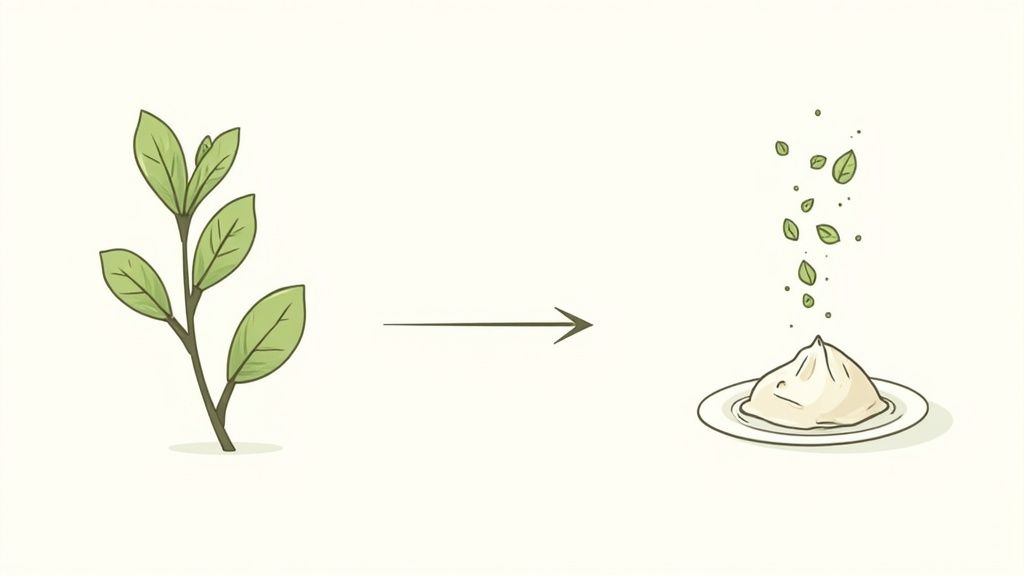
The "agave vs. stevia" debate doesn't really have a winner. The best choice comes down to your personal health goals and what you're making in the kitchen. Instead of looking for a single perfect sweetener, it’s better to think about what you need it to do. Your situation dictates the right answer.
This shift toward personalized nutrition is clear in market trends. The global stevia market was valued at USD 818.69 million in 2024 and is expected to hit USD 1.48 billion by 2033. This growth is all about people wanting zero-calorie options. This data points to a major move toward sweeteners that fit specific dietary needs.
Choose Stevia If...
Stevia is the clear winner if you need to keep a close eye on your blood sugar or are committed to a low-carb lifestyle. Its zero-calorie, zero-glycemic profile makes it the go-to in these scenarios.
- You're managing diabetes: Stevia doesn’t affect blood glucose or insulin levels, which makes it a safe and reliable choice. You can find more in-depth advice in our guide to sugar alternatives for diabetics.
- You're on a ketogenic diet: With zero carbs, stevia lets you enjoy a little sweetness without getting kicked out of ketosis.
- Your main goal is cutting calories: It sweetens up drinks and food without adding a single calorie to your daily count.
Stevia’s biggest strength is its purity. It gives you the sweetness you crave without any of the metabolic baggage, making it an essential tool when sugar and calories are off-limits.
Choose Agave If...
Agave is something to be used with caution, but it can be a good option for people without metabolic issues who are looking for a natural liquid sweetener.
Consider using agave in moderation if:
- You need a vegan alternative to honey: Its syrupy consistency is fantastic for drizzling over oatmeal, yogurt, or pancakes.
- You're sweetening cold beverages: It dissolves beautifully in iced tea, coffee, or cocktails, so you won't get that gritty texture at the bottom of your glass.
Agave vs. Stevia: Your Questions Answered
When you're standing in the sweetener aisle, it's easy to get bogged down in the details. Let's clear up a few of the most common questions people have when choosing between agave and stevia.
Can I Just Swap Agave for Stevia in a Recipe?
Definitely not. Trying a one-for-one swap is a recipe for disaster because these two sweeteners couldn't be more different in how they behave. Agave is a syrup, meaning it adds moisture, volume, and browning to your baked goods. Stevia, on the other hand, is an intensely sweet extract that offers zero bulk.
Think of it this way: if a muffin recipe calls for a cup of agave, you'd only need about a teaspoon of stevia to get the same level of sweetness. Making that direct switch would leave you with a dry, flat, and inedibly sweet result.
Is Agave Really Better Than High-Fructose Corn Syrup?
This is a huge point of confusion, largely thanks to marketing. While agave sounds more natural, its chemical makeup tells a different story. Agave nectar can contain as much as 90% fructose, which is often even higher than the concentration found in high-fructose corn syrup (HFCS).
Your liver processes the high fructose in agave almost exactly the same way it processes HFCS. Metabolically speaking, there’s no real advantage to choosing agave over its less-fashionable cousin.
Which One Tastes More Like Regular Sugar?
Neither one is a perfect dupe for table sugar, but agave usually gets closer for most people. Its taste is a mild, clean sweetness, kind of like a very light honey, which blends seamlessly into most recipes.
Stevia is a different beast altogether. It’s incredibly potent, but many people pick up on a distinct aftertaste that can range from slightly bitter to almost licorice-like. If you're aiming for a flavor that won't stand out, agave is the safer bet.